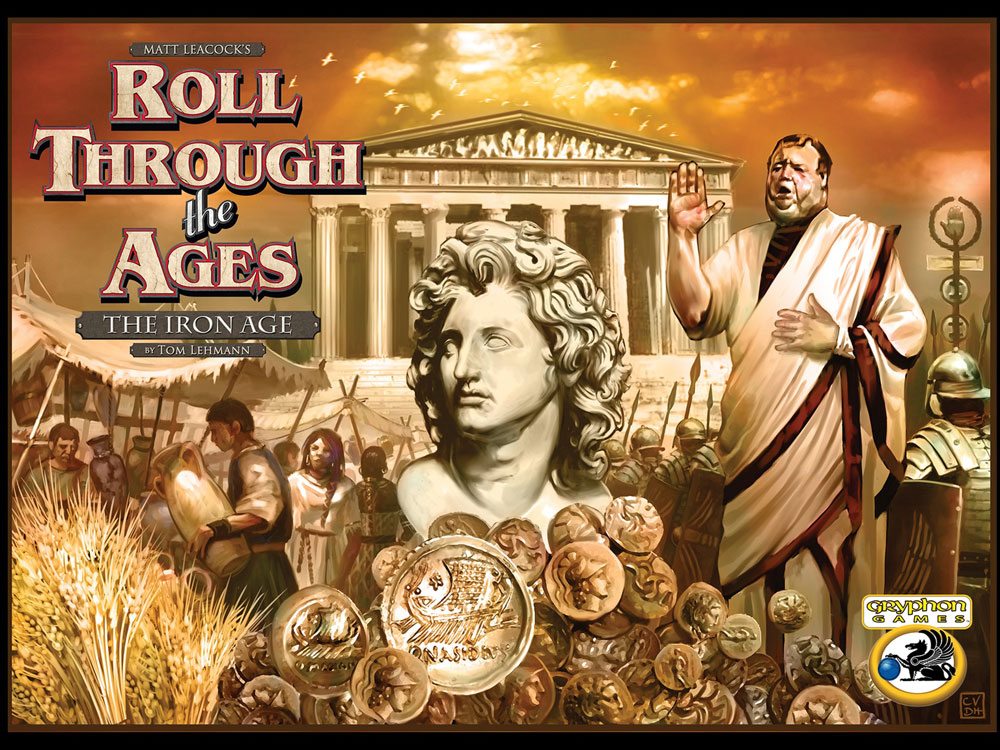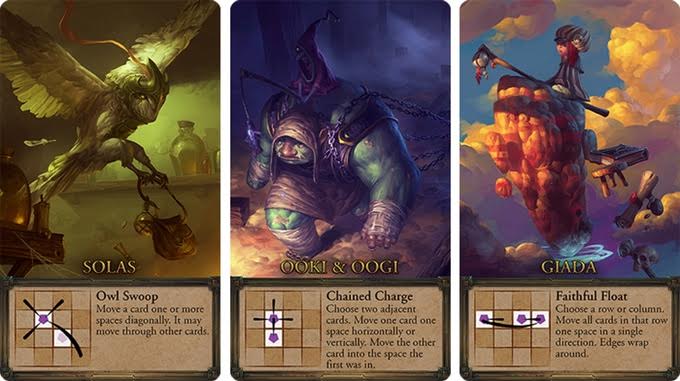In “Reaping the Rewards,” I take a look at a crowdfunded project in its final form. Today’s title is Roll Through the Ages: The Iron Age, a sequel (not an expansion) to Matt Leacock’s dice-rolling, civilization-building game. The game is similar to the original but has been beefed up, with new developments, warfare, and a Fate die. There’s also an included Mediterranean expansion that introduces exploration.
At a glance: Roll Through the Ages: The Iron Age is for 1 to 4 players, ages 10 and up, and takes 20-40 minutes to play. It retails for $44.99. It was funded successfully on Kickstarter in December of 2013, was delivered in the fall of 2014, and is available in stores and online now. It was designed by Tom Lehmann, expanding on Matt Leacock’s original design.
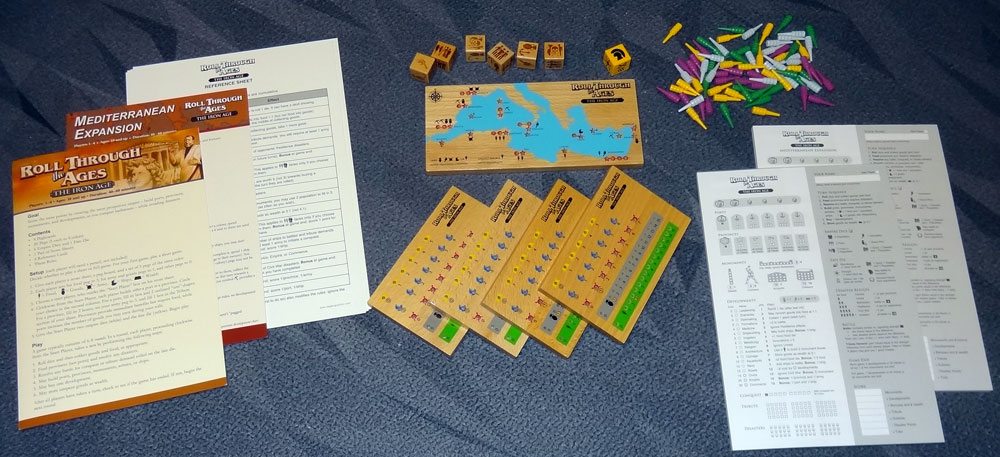
Components:
- 4 Player Pegboards
- 1 Colony Pegboard
- 60 Pegs (15 each in 4 colors)
- 6 Empire Dice
- 1 Fate Die
- 2 Score Sheet pads
- 4 Reference cards
Just as in the original game, the components are big, chunky wood. The pegboards are substantial slabs of wood with holes drilled in them and various icons and numbers painted on them. The wooden pegs fit properly into the holes. The dice are large wooden cubes–bigger than your standard six-sided dice–in a natural finish except for the yellow Fate Die.
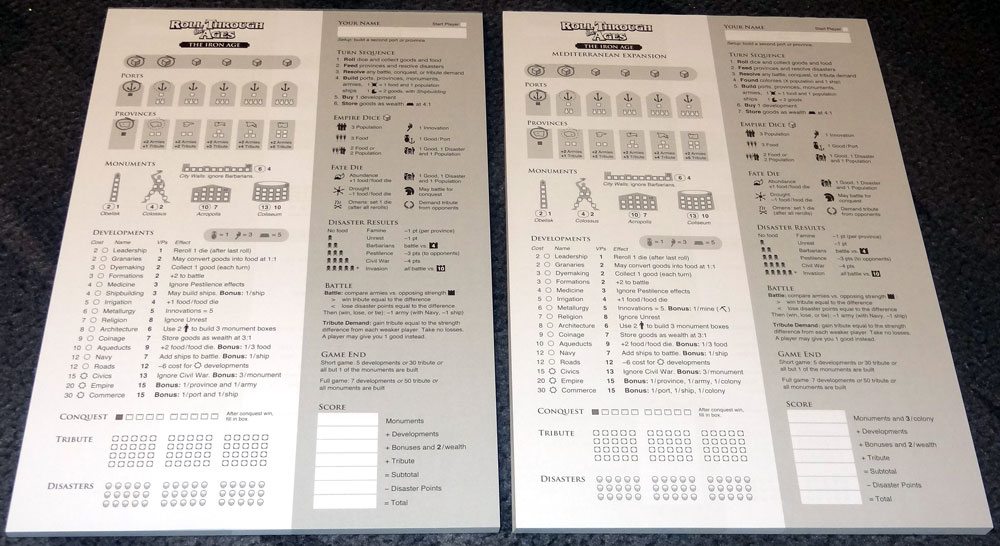
There are two pads of scoring sheets, one for the base game and one for the Mediterranean expansion. They differ just slightly, so be sure you’re using the right one. The sheets are standard 8.5″ x 11″ and have a lot of little checkboxes on them for marking off provinces and ports, monuments, developments, and so on. There’s a handy reference section on the right side of the sheet, explaining the turn order, dice icons, battle rules, and a scoring section for the end of the game. The sheets are also double-sided, so you can get two uses from each sheet.
The “reference cards” are actually large stiff sheets that detail all of the developments. They’re handy, but they’re huge and I’m not sure why they couldn’t have been a little smaller. That, and they’re double-sided with the same thing on both sides. I’m not sure if one side was supposed to have the Mediterranean expansion on it, but once you’ve played a few times you probably won’t need to refer to these.
The Mediterranean expansion rules are basically a single page–the only reason the rulesheet opens up at all is because the inside spread is a map of the Mediterranean Sea (and surrounding colonies) with historical notes about all of the colonies. So it’s a fun history lesson you could look at while waiting for your turn, I suppose.

Although the player pegboards and dice are the same size as the original, the larger scoresheets and added Mediterranean pegboard bumped this game up to a substantially larger box–though a big part of that increased size is for the plastic insert that holds everything in place. The original box didn’t have an insert at all.
How to Play
The goal is to have the most points by building up your empire.
I’ll explain the base game first, then the differences in the included Mediterranean expansion.
If you’ve played the original Roll Through the Ages, you’ll recognize a number of similarities, but there are various changes to the way the game works. Note that this is not an expansion–it’s a standalone game.
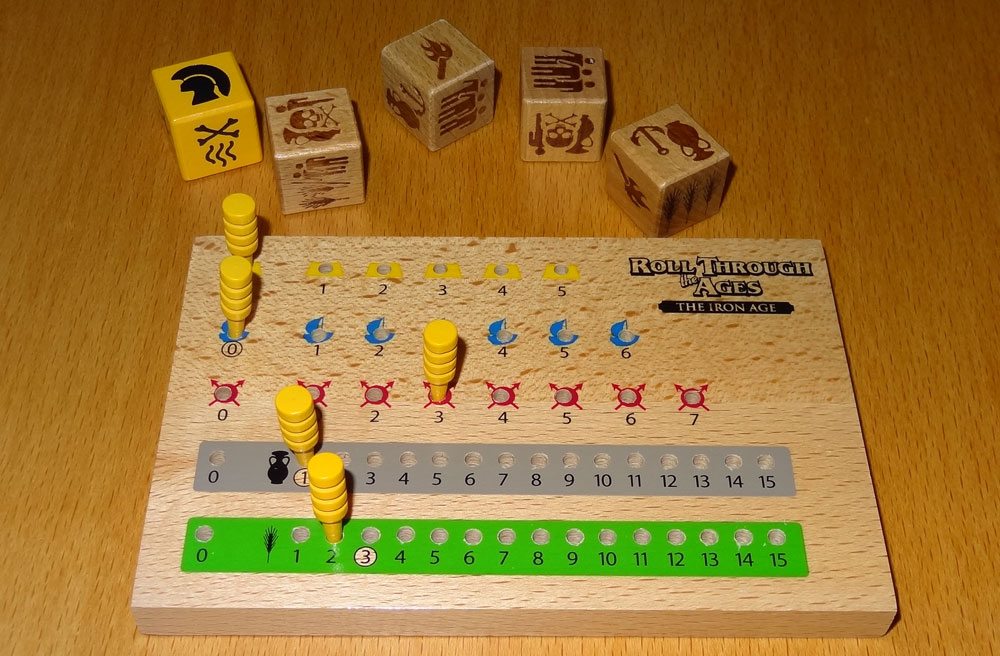
Each player gets a peg board, a score sheet, and 5 pegs. The pegs are placed on the board on their starting values: 3 Food, 1 Army, 1 Good, and 0 everything else. The starting player marks “start player” on the score sheet. Each player then gets to build either a port or a province for free. Circle your choice on the score sheet, and fill in the boxes or urns as appropriate. Ports give you the chance to get more goods during your turn; Provinces immediately give you armies and Tribute (worth points), but will also require food.
The starting player will get two empire dice (wood-colored) and the Fate Die to begin.
On your turn, you do the following:
- Roll dice and collect goods and food.
- Feed provinces and resolve disasters.
- Resolve battles or tribute demands.
- Build ports, provinces, monuments, armies, and ships.
- Buy one development.
- Store unspent goods as wealth.
The first three steps are mandatory, and the other three are optional. At the end of each full round, check to see if the game has ended–if not, then continue.
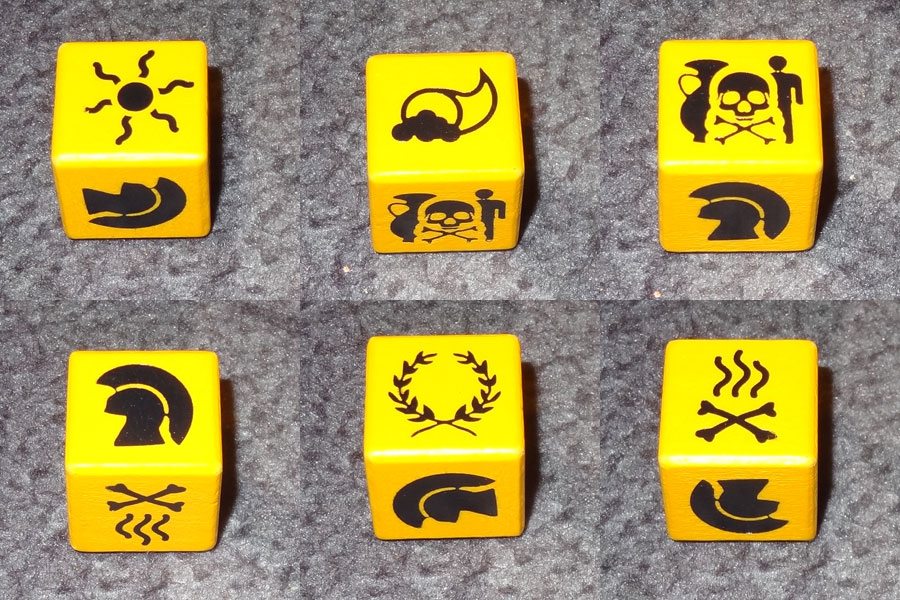
Roll and collect: You always roll the Fate Die, and you get as many Empire dice as you have provinces or ports, whichever is greater. You get three rolls total, and can re-roll any number of the dice (including the Fate Die) on each roll. However, any dice showing a skull are locked and cannot be rerolled.
The Fate Die has the following effects:
- Drought: subtract 1 food from every food die.
- Abundance: add 1 food to every food die.
- Disaster: same as empire dice: 1 good, 1 disaster, 1 populatoin.
- Conquest: you may battle for conquest.
- Tribute: you may demand tribute from opponents.
- Omens: you may set any one die to any face after your re-rolls.
You get 1 good for each of the skulls (which shows an urn, a skull and a person), plus you get 1 good per port for each of the Good/Port faces you rolled. Mark those on your pegboard. You collect 1 food for each wheat showing on the dice, and mark those on your pegboard also. (The face showing 2 wheat/2 people can be food or population but not both.)

Feed provinces, resolve disasters: Each of your provinces requires 1 food. For each province you can’t feed, mark off 1 disaster at the bottom of your score sheet. Then, resolve disasters (skulls). Depending on the number of skulls you rolled, you might need to mark off more disaster points, fight barbarians, or spread pestilence to your opponents.
Resolve battles: Sometimes you’ll have to fight because of disasters, and sometimes the Fate Die will allow you to battle for conquest or demand tribute from neighboring tribes. In those cases, you compare your battle strength to whatever it is you’re fighting–barbarians have 4 strength, invasions have 10 strength, and neighboring tribes are represented by your opponents and their own battle strengths. There’s a conquest track on your sheet that starts at 1–each time you battle for conquest, you fill in a conquest box, which increases the conquest strength. Your strength is usually equal to your armies, but there are developments that can increase it or add your ships to your strength. If your strength is higher, you get Tribute points equal to the difference. If it’s lower, you get disaster points instead (though you don’t take any disaster points in a tribute demand–you just get nothing). Then, whether you won or lost, you lose 1 army.
Build: Building requires population, represented by people on the dice. For each person showing, you can fill in one box somewhere on your score sheet. You can also spend goods to fill in the urns for the Ports. Whenever you fully fill in the spaces for a Port or Province, you circle it and potentially increase the number of dice you will roll next turn. You also get immediate bonuses for Provinces in the form of armies and Tribute. For monuments, the first person to finish each monument type will get the higher score shown, and all other players who finish a monument get the lower score.
Armies cost 1 population and 1 food, and Ships cost 2 goods but only if you already have the Shipbuilding development.
Development: You may buy 1 development each round–these are the real civilization-building aspect of the game. You spend goods (on your pegboard, worth 1), innovation (the torch icon on the dice, worth 3), and wealth (on your pegboard, worth 5) to buy developments. Each development provides a certain number of points and also has some game effects.
Store goods: You can convert goods to wealth on your pegboard at a rate of 4 to 1. Since wealth is worth 5 when spent on developments, this is a good deal unless you’re planning to use the goods for ports or ships.
You can play a short game or a long game, which determines the end game conditions.
Short game: A player buys a 5th development or a player has 30 or more tribute or there is at most 1 monument type that has not been built by any player.
Long game: A player buys a 7th development or a player has 50 or more tribute or every monument has been built at least once.
When any of the game end conditions are met, that round is finished and then the game ends. You get points for your monuments and developments–some developments also award bonus points. You get points for tribute and unspent wealth, and lose points for disaster. Highest score wins; ties go to the most “pegged positions” on the pegboard.
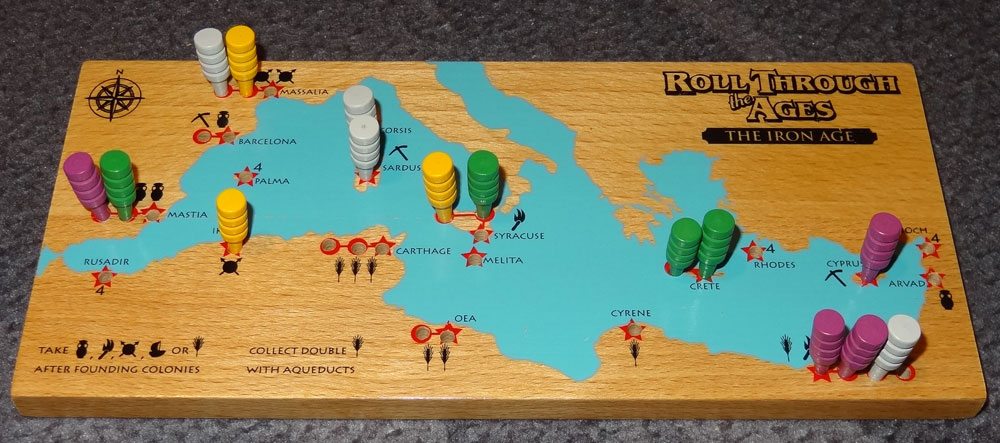
Mediterranean Expansion
For the Mediterranean expansion, you’ll use the Colony pegboard in the center of the table, and each player takes 15 pegs and the expansion scoresheet.
In the expansion, everyone has the Shipbuilding development to begin with and can build ships.
There’s an extra step: Found Colonies. You spend 1 population per peg to add your pegs to the Colony board, which shows various colonies of different sizes. Incomplete colonies may have pegs from more than one player. To complete a colony, you must place the last peg you and also spend 1 ship.
If you want to complete a colony and there are other players’ pegs in that colony, you must also spend 2 population per peg to displace the other players’ pegs (in addition to the 1 ship usually required). You can only displace pegs on the turn when you complete a colony, and completed colonies are safe from displacement.
If you complete a colony, you get the bonuses shown next to them: some award goods, armies, ships, or food, which are marked on your pegboard. Innovation must be spent that turn or lost. Mine symbols will be worth points if you have the Metallurgy development, but otherwise have no effect.
At the end of the game, each completed colony is worth 3 points regardless of size.
Solitaire Rules
There are solitaire rules provided for the base game and expansion as well. Basically you play an 8-round game, trying to beat 100 points. Pestilence affects you instead of opponents, and Tribute demands are against an opponent of strength equal to the current round number. In the expansion, you roll a 6-sided die to determine whether an opponent completes any colonies.
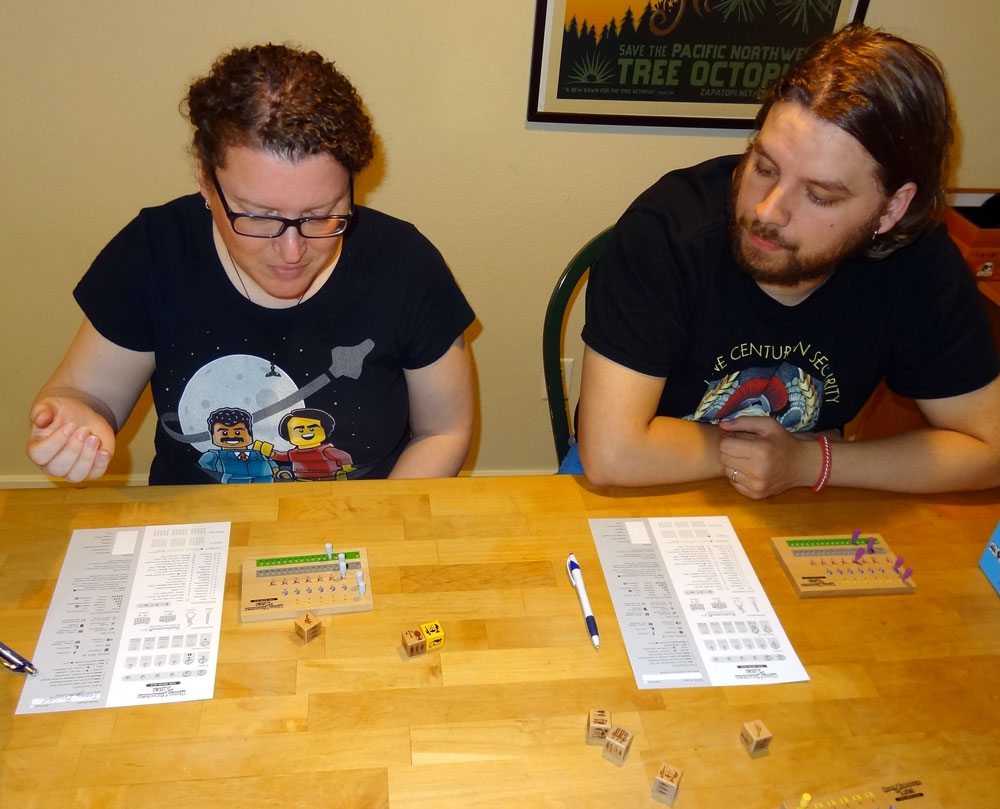
The Verdict
I’m still a fan of the original Roll Through the Ages, but The Iron Age adds some elements that I think improve the game, particularly in the way that players interact with each other. In the original, the main way you interact with other players is through Pestilence: if you roll exactly 3 skulls, then that costs other players points instead of you. You can purchase the “Medicine” development to protect against Pestilence, but it’s not worth as many points. And there was the race to finish a monument first so you could get the higher score for it.
In The Iron Age, the tribute demands are another way to score points that’s dependent on the other players. If everyone has comparable armies, then nobody will score a lot of points for tribute. But if there is a power discrepancy, that can lead to a lot of points for the stronger army. That said, it’s not a direct attack, because demanding tribute from your opponents doesn’t actually take anything from them–you just score some points and they don’t lose anything. They can, however, bribe you with 1 Good so that you don’t score the tribute points–a good idea in cases where you could score big.

The components are fantastic–the huge, chunky wood dice and pegboards are solid and substantial, appropriate for a game about building civilization from the ground up. I think the game certainly could have been made with just a player board and cardboard chits, but the tactile and visual experience is more satisfying with the wooden bits. The downside, of course, is that it’s heavy–this is probably not the sort of game that I’ll pack for trips, particularly because the box is substantially larger than the original game.
There is, of course, still luck involved. After all, it’s a game where your primary mechanic is rolling dice. However, I like that there is strategy in how you use your dice, what you choose to reroll, and what developments you buy. Do you take big risks to try for a greater reward? Or do you play it safe, buying smaller developments that will protect you from disasters? The Fate Die adds even more chance–the difference between getting a Drought or Abundance can be huge if you need that food to feed all of your provinces.
The choice between provinces and ports is also a new decision. Both of them can help you, but ports are an economic strategy and provinces are a warfare strategy. You can try to get some of each, but then it takes longer to roll more dice on your turn. So far I’ve seen winners from both camps (ports and provinces) so it doesn’t seem like either is strictly better than the other; it depends on how you use them and, of course, how your luck holds up.
I love the variety in the developments, and looking for good combinations that work well together. Usually even if we start off saying we’ll play the short game, we end up continuing on to the long game. 5 developments feels like you’ve just started building up your civilization and haven’t gotten to use all the bonuses yet.
The Mediterranean expansion adds even more player interaction, mostly in the form of racing. You race to complete colonies so you can score points and get the bonuses. But even when you can’t complete a colony, sometimes it’s worth sending people just to make it more expensive for somebody else to complete. When you have population to spend, you have to decide whether to build up your own things (ports, provinces, monuments) or risk them on colonization.
The biggest downside I found to the game (as with the original) is that, aside from the occasional disasters or tribute demands, you don’t do a lot when it’s not your turn. It’s pretty much up to the active player to roll dice, make decisions, check boxes, and everyone else just watches. Usually the turns are short enough that it’s not too bad–after all, you only get 3 rolls on your turn, and you have a maximum of 7 dice. However, because of all the different options at hand, players with analysis paralysis can take a long time even deciding which dice to re-roll. And the more dice you’re rolling, the more options become available to you, making decisions harder. Other than choosing an arbitrary time limit for each turn, there’s not much you can do about that.
Overall, though, I think The Iron Age is a fine sequel to Roll Through the Ages. The included Mediterranean expansion adds some variety for replay value, and it still preserves that civlization-building-in-a-nutshell that I enjoyed in the original, though it’s a bit more involved. If you’re an experienced, I would recommend skipping it and jumping straight to this one, unless you also want one that you can pack for trips. The original is still an easier introduction for casual gamers. Roll Through the Ages: The Iron Age is in stores now or can be purchased online.
Disclosure: GeekDad received a review copy of this game.

